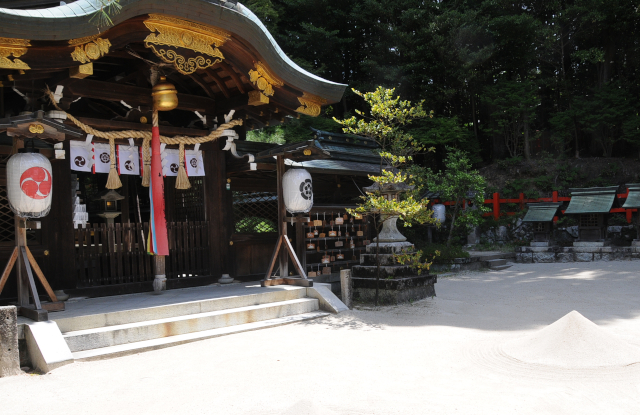At the end of May, I decided to explore my neighborhood and visit Hachidai Jinja, a famous shrine that dates back to the 13th century, when the whole area was very much outside of Kyoto still. In fact, the Ichijoji village (named after a temple that ceased to exist in 1335) was only incorporated into Kyoto City in 1931. But I digress.
The main deity of the shrine is Susanoo-no-mikoto, the brother of the sun goddess. While Yasaka Jinja (the shrine celebrating Gion Matsuri) is the head shrine for Susanoo, Hachidai Jinja is often called the “northern Yasaka”. Interestingly, Saginomori Jinja, which is even further north, also enshrines Susanoo-no-mikoto, but perhaps he was added to the local pantheon there a bit later.
Hachidai Jinja once had much larger precincts, but today it is fairly small. Passing through a torii, a steep slope leads to the main part, and the main hall (built 1926) lies on top of a few more steps. People come here to pray to exorcise evil spirits, for academic success and matchmaking, among other things.

The shrine is also responsible to provide protection from “directional evil”. It protects the city in particular from evil that comes from the north-east, and was once one of 12 shrines that protected the city.
Nowadays Hachidai Jinja is famous for its connection to a single event: The fight between Miyamoto Musashi and the Yoshioka clan at Sagarimatsu Pine, in 1604. At the time, the pine stood still on the shrine grounds, and it is said that young Musashi went to pray before the fight. However, he changed his mind when he realized that he should only rely upon his own strength and went into battle without prayers. The gods must have favored him regardless, since he was able to wipe out the entire clan during that night.

At the spot of the fight, the fifth descendant of the famous pine still stands to this day; at the shrine itself, the stump of the original tree has been enshrined in a glass case. Next to it, erected only in 2002, stands a statue of Musashi, imagined at only 21 years old (as he was during the fight) and holding his two swords.

It was nice to explore the history of the neighborhood, even though I wouldn’t call the shrine itself spectacular. Unfortunately, even though it is pretty high up in the Higashiyama mountains, there is no view from the precincts; for that you should visit Shisen-do temple just below the shrine. I have done that, of course, and will report about this visit in due course.
